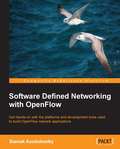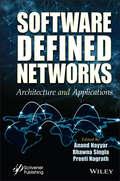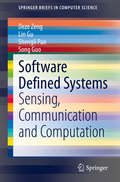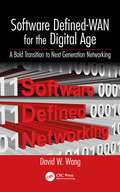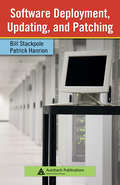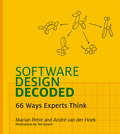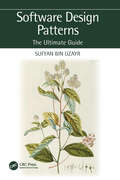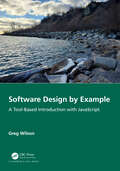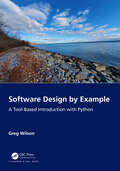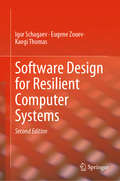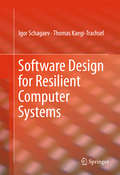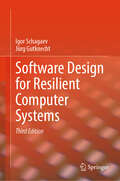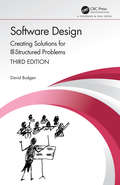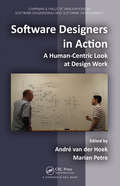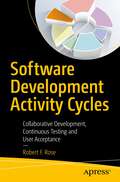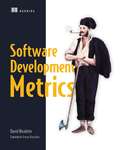- Table View
- List View
Software Defined Networking Applications in Distributed Datacenters
by Heng Qi Keqiu LiThis SpringerBrief provides essential insights on the SDN application designing and deployment in distributed datacenters. In this book, three key problems are discussed: SDN application designing, SDN deployment and SDN management. This book demonstrates how to design the SDN-based request allocation application in distributed datacenters. It also presents solutions for SDN controller placement to deploy SDN in distributed datacenters. Finally, an SDN management system is proposed to guarantee the performance of datacenter networks which are covered and controlled by many heterogeneous controllers. Researchers and practitioners alike will find this book a valuable resource for further study on Software Defined Networking.
Software Defined Networking for Ad Hoc Networks (EAI/Springer Innovations in Communication and Computing)
by Sabyasachi Pramanik Mangesh M. Ghonge Amol D. PotgantwarThis book offers a comprehensive overview of Software-Defined Network (SDN) based ad-hoc network technologies and exploits recent developments in this domain, with a focus on emerging technologies in SDN based ad-hoc networks. The authors offer practical and innovative applications in Network Security, Smart Cities, e-health, and Intelligent Systems. This book also addresses several key issues in SDN energy-efficient systems, the Internet of Things, Big Data, Cloud Computing and Virtualization, Machine Learning, Deep Learning, and Cryptography. The book includes different ad hoc networks such as MANETs and VANETs, along with a focus on evaluating and comparing existing SDN-related research on various parameters. The book provides students, researchers, and practicing engineers with an expert guide to the fundamental concepts, challenges, architecture, applications, and state-of-the-art developments in the field.
Software Defined Networking with OpenFlow
by Siamak AzodolmolkyA step-by-step, example-based guide which will help you gain hands-on experience with the platforms and debugging tools on OpenFlow.If you are a network engineer, architect, junior researcher or an application developer, this book is ideal for you. You will need to have some level of network experience, knowledge of broad networking concepts, and some familiarity with day- to- day operation of computer networks. Ideally, you should also be familiar with programing scripting/languages (especially Python and Java), and system virtualization.
Software Defined Networking: Design and Deployment
by Patricia A. MorrealeSoftware Defined Networking: Design and Deployment provides a comprehensive treatment of software defined networking (SDN) suitable for new network managers and experienced network professionals. Presenting SDN in context with more familiar network services and challenges, this accessible text:Explains the importance of virtualization, particularly
Software Defined Networks: Architecture and Applications
by Anand Nayyar Bhawna Singla Preeti NagrathSOFTWARE DEFINED NETWORKS Software defined networking suggests an alternative worldview, one that comes with a new software stack to which this book is organized, with the goal of presenting a top-to-bottom tour of SDN without leaving any significant gaps that the reader might suspect can only be filled with magic or proprietary code. Software defined networking (SDN) is an architecture designed to make a network more flexible and easier to manage. SDN has been widely adopted across data centers, WANs, and access networks and serves as a foundational element of a comprehensive intent-based networking (IBN) architecture. Although SDN has so far been limited to automated provisioning and configuration, IBN now adds “translation” and “assurance” so that the complete network cycle can be automated, continuously aligning the network to business needs. In 14 chapters, this book provides a comprehensive understanding of an SDN-based network as a scalable distributed system running on commodity hardware. The reader will have a one-stop reference looking into the applications, architectures, functionalities, virtualization, security, and privacy challenges connected to SDN. Audience Researchers in software, IT, and electronic engineering as well as industry engineers and technologists working in areas such as network virtualization, Python network programming, CISCO ACI, software defined network, and cloud computing.
Software Defined Systems: Sensing, Communication and Computation (SpringerBriefs in Computer Science)
by Song Guo Deze Zeng Lin Gu Shengli PanThis book introduces the software defined system concept, architecture, and its enabling technologies such as software defined sensor networks (SDSN), software defined radio, cloud/fog radio access networks (C/F-RAN), software defined networking (SDN), network function virtualization (NFV), software defined storage, virtualization and docker. The authors also discuss the resource allocation and task scheduling in software defined system, mainly focusing on sensing, communication, networking and computation. Related case studies on SDSN, C/F-RAN, SDN, NFV are included in this book, and the authors discuss how these technologies cooperate with each other to enable cross resource management and task scheduling in software defined system. Novel resource allocation and task scheduling algorithms are introduced and evaluated. This book targets researchers, computer scientists and engineers who are interested in the information system softwarization technologies, resource allocation and optimization algorithm design, performance evaluation and analysis, next-generation communication and networking technologies, edge computing, cloud computing and IoT. Advanced level students studying these topics will benefit from this book as well.
Software Defined-WAN for the Digital Age: A Bold Transition to Next Generation Networking
by David W. WangSD-WAN is an advanced networking approach that creates hybrid networks to integrate broadband or other network services into the corporate WAN, not only just handling general business workloads and traffic, but also being capable of maintaining the performance and security of real-time and sensitive applications. This book posits that Software Defined (SD) WAN is the answer to questions such as what changes can be made to the networking sector? What innovations can make WAN, which plays a vital integrated part of the cloud ecosystem, more cost effective, performance robust, provisioning efficient, and operation intelligent?
Software Deployment, Updating, and Patching
by Bill Stackpole Patrick HanrionThe deployment of software patches can be just as challenging as building entirely new workstations. Training and support issues can haunt even the most successful software launch for months. Preparing for the rigors of software deployment includes not just implementing change, but training employees, predicting and mitigating pitfalls, and managin
Software Design Decoded: 66 Ways Experts Think (The MIT Press)
by Marian Petre Yen Quach André van der HoekWhat makes an expert software designer? It is more than experience or innate ability. Expert software designers have specific habits, learned practices, and observed principles that they apply deliberately during their design work. This book offers sixty-six insights, distilled from years of studying experts at work, that capture what successful software designers actually do to create great software. The book presents these insights in a series of two-page illustrated spreads, with the principle and a short explanatory text on one page, and a drawing on the facing page. For example, "Experts generate alternatives" is illustrated by the same few balloons turned into a set of very different balloon animals. The text is engaging and accessible; the drawings are thought-provoking and often playful.Organized into such categories as "Experts reflect," "Experts are not afraid," and "Experts break the rules," the insights range from "Experts prefer simple solutions" to "Experts see error as opportunity." Readers learn that "Experts involve the user"; "Experts take inspiration from wherever they can"; "Experts design throughout the creation of software"; and "Experts draw the problem as much as they draw the solution." One habit for an aspiring expert software designer to develop would be to read and reread this entertaining but essential little book. The insights described offer a guide for the novice or a reference for the veteran -- in software design or any design profession.A companion web site provides an annotated bibliography that compiles key underpinning literature, the opportunity to suggest additional insights, and more.
Software Design Decoded: 66 Ways Experts Think (The\mit Press Ser.)
by Marian Petre Andre Van Der HoekAn engaging, illustrated collection of insights revealing the practices and principles that expert software designers use to create great software.What makes an expert software designer? It is more than experience or innate ability. Expert software designers have specific habits, learned practices, and observed principles that they apply deliberately during their design work. This book offers sixty-six insights, distilled from years of studying experts at work, that capture what successful software designers actually do to create great software. The book presents these insights in a series of two-page illustrated spreads, with the principle and a short explanatory text on one page, and a drawing on the facing page. For example, “Experts generate alternatives” is illustrated by the same few balloons turned into a set of very different balloon animals. The text is engaging and accessible; the drawings are thought-provoking and often playful.Organized into such categories as “Experts reflect,” “Experts are not afraid,” and “Experts break the rules,” the insights range from “Experts prefer simple solutions” to “Experts see error as opportunity.” Readers learn that “Experts involve the user”; “Experts take inspiration from wherever they can”; “Experts design throughout the creation of software”; and “Experts draw the problem as much as they draw the solution.” One habit for an aspiring expert software designer to develop would be to read and reread this entertaining but essential little book. The insights described offer a guide for the novice or a reference for the veteran—in software design or any design profession.A companion web site provides an annotated bibliography that compiles key underpinning literature, the opportunity to suggest additional insights, and more.
Software Design Patterns: The Ultimate Guide
by Sufyan bin UzayrSoftware Design Patterns are reusable solutions to software development difficulties. However, a Software Design Pattern is not code; rather, it is a guide or paradigm that helps software engineers to construct products that follow best practices. A Design Pattern is more of a template to tackle the topic at hand than a library or framework, which can be added and utilized right away. Object-oriented programming (OOP) is supported by Design Patterns, which are based on the ideas of objects (instances of a class; data with unique attributes) and classes (user-defined types of data). Design Patterns are blueprints for resolving typical software engineering issues. They provide reproducible solutions to some of the most prevalent difficulties you’ll encounter. That said, Design Patterns aren’t a complete solution, nor are they code, classes, or libraries that you may use in your project. They are a type of problem-solving solution. Each job will be approached in a slightly different way. Why Should You Learn Software Design Patterns? As a programmer, you can use Software Design Patterns to help you build more reliable structures. Design Patterns give you the skills to create smart and interactive applications or software with simple and easy problem-solving methods; they also allow you to create the greatest user-friendly apps and change them easily to meet the latest requirements. Design Patterns are interesting to deal with since such knowledge enables flexible coding patterns and structural techniques, reusable codes, loosely written codes, classes, patterns, and so on. This Book Contains: • A step-by-step approach to problem solving and skill development • A quick run-through of the basic concepts, in the form of a "Crash Course" • Advanced, hands-on core concepts, with a focus on real-world problems • Industry level coding paradigm with practice-oriented explanations • Special emphasis on writing clean and optimized code, with additional chapters focused on coding methodology
Software Design X-Rays: Fix Technical Debt with Behavioral Code Analysis
by Adam TornhillAre you working on a codebase where cost overruns, death marches, and heroic fights with legacy code monsters are the norm? Battle these adversaries with novel ways to identify and prioritize technical debt, based on behavioral data from how developers work with code. And that's just for starters. Because good code involves social design, as well as technical design, you can find surprising dependencies between people and code to resolve coordination bottlenecks among teams. Best of all, the techniques build on behavioral data that you already have: your version-control system. Join the fight for better code! Use statistics and data science to uncover both problematic code and the behavioral patterns of the developers who build your software. This combination gives you insights you can't get from the code alone. Use these insights to prioritize refactoring needs, measure their effect, find implicit dependencies between different modules, and automatically create knowledge maps of your system based on actual code contributions. In a radical, much-needed change from common practice, guide organizational decisions with objective data by measuring how well your development teams align with the software architecture. Discover a comprehensive set of practical analysis techniques based on version-control data, where each point is illustrated with a case study from a real-world codebase. Because the techniques are language neutral, you can apply them to your own code no matter what programming language you use. Guide organizational decisions with objective data by measuring how well your development teams align with the software architecture. Apply research findings from social psychology to software development, ensuring you get the tools you need to coach your organization towards better code. If you're an experienced programmer, software architect, or technical manager, you'll get a new perspective that will change how you work with code.What You Need:You don't have to install anything to follow along in the book. TThe case studies in the book use well-known open source projects hosted on GitHub. You'll use CodeScene, a free software analysis tool for open source projects, for the case studies. We also discuss alternative tooling options where they exist.
Software Design by Example: A Tool-Based Introduction with JavaScript
by Greg WilsonThe best way to learn design in any field is to study examples, and some of the best examples of software design come from the tools programmers use in their own work. Software Design by Example: A Tool-Based Introduction with JavaScript therefore builds small versions of the things programmers use in order to demystify them and give some insights into how experienced programmers think. From a file backup system and a testing framework to a regular expression matcher, a browser layout engine, and a very small compiler, we explore common design patterns, show how making code easier to test also makes it easier to re-use, and help readers understand how debuggers, profilers, package managers, and version control systems work so that they can use them more effectively. This material can be used for self-paced study, in an undergraduate course on software design, or as the core of an intensive weeklong workshop for working programmers. Each chapter has a set of exercises ranging in size and difficulty from half a dozen lines to a full day's work. Readers should be familiar with the basics of modern JavaScript, but the more advanced features of the language are explained and illustrated as they are introduced. All the written material in this project can be freely reused under the terms of the Creative Commons - Attribution license, while all of the software is made available under the terms of the Hippocratic License. All proceeds from sale of this book will go to support the Red Door Family Shelter in Toronto. Features Teaches software design by showing programmers how to build the tools they use every day Each chapter includes exercises to help readers check and deepen their understanding All the example code can be downloaded, re-used, and modified under an open license
Software Design by Example: A Tool-Based Introduction with Python
by Greg WilsonThe best way to learn design in any field is to study examples, and some of the best examples of software design come from the tools programmers use in their own work. Software Design by Example: A Tool-Based Introduction with Python therefore builds small versions of the things programmers use in order to demystify them and give some insights into how experienced programmers think. From a file backup system and a testing framework to a regular expression matcher, a browser layout engine, and a very small compiler, we explore common design patterns, show how making code easier to test also makes it easier to reuse, and help readers understand how debuggers, profilers, package managers, and version control systems work so that they can use them more effectively.This material can be used for self-paced study, in an undergraduate course on software design, or as the core of an intensive weeklong workshop for working programmers. Each chapter has a set of exercises ranging in size and difficulty from half a dozen lines to a full day’s work. Readers should be familiar with the basics of modern Python, but the more advanced features of the language are explained and illustrated as they are introduced.All the written material in this project can be freely reused under the terms of the Creative Commons - Attribution license, while all of the software is made available under the terms of the Hippocratic License. All proceeds from sale of this book will go to support the Red Door Family Shelter in Toronto.Features:• Teaches software design by showing programmers how to build the tools they useevery day• Each chapter includes exercises to help readers check and deepen their understanding• All the example code can be downloaded, re-used, and modified under an open license
Software Design for Flexibility: How to Avoid Programming Yourself into a Corner
by Chris Hanson Gerald Jay SussmanStrategies for building large systems that can be easily adapted for new situations with only minor programming modifications.Time pressures encourage programmers to write code that works well for a narrow purpose, with no room to grow. But the best systems are evolvable; they can be adapted for new situations by adding code, rather than changing the existing code. The authors describe techniques they have found effective--over their combined 100-plus years of programming experience--that will help programmers avoid programming themselves into corners.The authors explore ways to enhance flexibility by: • Organizing systems using combinators to compose mix-and-match parts, ranging from small functions to whole arithmetics, with standardized interfaces • Augmenting data with independent annotation layers, such as units of measurement or provenance • Combining independent pieces of partial information using unification or propagation • Separating control structure from problem domain with domain models, rule systems and pattern matching, propagation, and dependency-directed backtracking • Extending the programming language, using dynamically extensible evaluators
Software Design for Resilient Computer Systems
by Igor Schagaev Eugene Zouev Kaegi ThomasThis book addresses the question of how system software should be designed to account for faults, and which fault tolerance features it should provide for highest reliability. With this second edition of Software Design for Resilient Computer Systems the book is thoroughly updated to contain the newest advice regarding software resilience. With additional chapters on computer system performance and system resilience, as well as online resources, the new edition is ideal for researchers and industry professionals.The authors first show how the system software interacts with the hardware to tolerate faults. They analyze and further develop the theory of fault tolerance to understand the different ways to increase the reliability of a system, with special attention on the role of system software in this process. They further develop the general algorithm of fault tolerance (GAFT) with its three main processes: hardware checking, preparation for recovery, and the recovery procedure. For each of the three processes, they analyze the requirements and properties theoretically and give possible implementation scenarios and system software support required. Based on the theoretical results, the authors derive an Oberon-based programming language with direct support of the three processes of GAFT. In the last part of this book, they introduce a simulator, using it as a proof of concept implementation of a novel fault tolerant processor architecture (ERRIC) and its newly developed runtime system feature-wise and performance-wise. Due to the wide reaching nature of the content, this book applies to a host of industries and research areas, including military, aviation, intensive health care, industrial control, and space exploration.
Software Design for Resilient Computer Systems
by Igor Schagaev Thomas Kaegi-TrachselThis book addresses the question of how system software should be designed to account for faults, and which fault tolerance features it should provide for highest reliability. The authors first show how the system software interacts with the hardware to tolerate faults. They analyze and further develop the theory of fault tolerance to understand the different ways to increase the reliability of a system, with special attention on the role of system software in this process. They further develop the general algorithm of fault tolerance (GAFT) with its three main processes: hardware checking, preparation for recovery, and the recovery procedure. For each of the three processes, they analyze the requirements and properties theoretically and give possible implementation scenarios and system software support required. Based on the theoretical results, the authors derive an Oberon-based programming language with direct support of the three processes of GAFT. In the last part of this book, they introduce a simulator, using it as a proof of concept implementation of a novel fault tolerant processor architecture (ERRIC) and its newly developed runtime system feature-wise and performance-wise. The content applies to industries such as military, aviation, intensive health care, industrial control, space exploration, etc.
Software Design for Resilient Computer Systems
by Igor Schagaev Jürg GutknechtThis book addresses the question of how system software should be designed to account for faults, and which fault tolerance features should provide for highest reliability. With this third edition of Software Design for Resilient Computer Systems, the book is thoroughly updated to contain the newest advice regarding software resilience. With a new introductory chapter, the new edition is ideal for researchers and industry professionals. In the book, the authors first show how system software interacts with the hardware to tolerate faults. They analyze and further develop the theory of fault tolerance to understand the diverse ways to increase the reliability of a system, with special attention on the role of system software in this process. They introduce the theory of redundancy and its use for construction of a subsystem through generalised algorithm of fault tolerance (GAFT) and apply it to distributed systems. The book’s approach is applied to various hardware subsystems: different structures of RAM and processor cores and demonstrates exceptional performance reliability and energy efficiency. This third edition devotes substantial attention to system software for modern computers, including run time systems, supporting algorithms of recovery and their analysis, language aspects and ways to improve reconfigurable and parallel computing. Due to the wide-reaching nature of the content, this book applies to a host of industries and research areas, including military, aviation, intensive health care, industrial control, and space exploration.
Software Design: A Comprehensive Guide to Software Development Projects
by Murali ChemuturiThis book is perhaps the first attempt to give full treatment to the topic of Software Design. It will facilitate the academia as well as the industry. This book covers all the topics of software design including the ancillary ones.
Software Design: Creating Solutions for Ill-Structured Problems (Chapman & Hall/CRC Innovations in Software Engineering and Software Development Series)
by David BudgenSoftware Design: Creating Solutions for Ill-Structured Problems, Third Edition provides a balanced view of the many and varied software design practices used by practitioners. The book provides a general overview of software design within the context of software development and as a means of addressing ill-structured problems. The third edition has been expanded and reorganised to focus on the structure and process aspects of software design, including architectural issues, as well as design notations and models. It also describes a variety of different ways of creating design solutions such as plan-driven development, agile approaches, patterns, product lines, and other forms. Features •Includes an overview and review of representation forms used for modelling design solutions •Provides a concise review of design practices and how these relate to ideas about software architecture •Uses an evidence-informed basis for discussing design concepts and when their use is appropriate This book is suitable for undergraduate and graduate students taking courses on software engineering and software design, as well as for software engineers. Author David Budgen is a professor emeritus of software engineering at Durham University. His research interests include evidence-based software engineering (EBSE), software design, and healthcare informatics.
Software Designers in Action: A Human-Centric Look at Design Work
by Marian Petre André van der HoekSoftware Designers in Action: A Human-Centric Look at Design Work examines how developers actually perform software design in their day-to-day work. The book offers a comprehensive look at early software design, exploring the work of professional designers from a range of different viewpoints. Divided into four sections, it discusses various theore
Software Developers as Users
by Clarisse Sieckenius de Souza Renato Fontoura de Gusmão Cerqueira Luiz Marques Afonso Rafael Rossi de Mello Brandão Juliana Soares Jansen FerreiraThis book presents the SigniFYI Suite of conceptual and methodological tools, designed to uncover meanings inscribed in software, their origins, intent and consequences to identify and trace correlating patterns; from software design and development to software use and experience. Based on the study of Semiotic Engineering, the book advances the study of Human-Centered Computing (HCC), inviting professionals, researchers, teachers and students to reflect upon how subjective and cultural values manifest themselves through software models, programs and user interfaces (UI). The authors weave a mesh of technical, theoretical and philosophical considerations of what it means to build and use software, exploring what we (professionals and non-professionals) mean by the pieces of software we design and develop, as well as what pieces of software mean to end-users and others. Explicitly dedicated to software designers, developers and users, Software Developers as Users is an exciting perspective of socio-technical communication in the digital age.
Software Development Activity Cycles: Collaborative Development, Continuous Testing and User Acceptance
by Robert F. RoseThe principal benefit this book is to provide a holistic and comprehensible view of the entire software development process, including ongoing evolution and support. It treats development as a collaborative effort with triad communication between a tester, a programmer, and a representative from the user community or a Subject Matter Expert (SME). Progress is measured by user acceptance in each cycle before proceeding to the next step of an activity. There is no test stage in the DPAC model: continuous testing is represented in the backswing (Check Phase) of each activity cycle. This approach posits that there exists some “happy path” that represents the intent of the project as declared by the objectives of a Vision Statement, and that this path can be revealed by an iterative and incremental process of “freeing the statue from the stone.” As the image of this path unfolds, more waste is removed while retaining conceptual integrity. The example presented herein walks the reader through an application of the model. This book should be of great interest to Product and Project Managers new to the concept of a lean agile development effort, and all practitioners of an agile methodology or those considering or just beginning an agile journey.What You'll LearnSee how the various disciplines constituting the software development process come togetherUnderstand where in the development process management, you can exercise measurement of progress and controlReview how a quality engineering program will positively affect the quality of the development processExamine how the quality of the development process profoundly affects the quality of the software systemWho This Book Is ForManagers, from the C-Suite (CEO,CXO, CIO) to line managers including project managers, and practitioners including programmers, testers, and mid-level managers (Technical Project Managers, Software Quality Engineers, and Coaches). Also, Agile enthusiasts who are looking for a software development methodology on which to place their hat.
Software Development From A to Z: A Deep Dive into all the Roles Involved in the Creation of Software
by Olga Filipova Rui VilãoUnderstand the big picture of the software development process. We use software every day – operating systems, applications, document editing programs, home banking – but have you ever wondered who creates software and how it’s created? This book guides you through the entire process, from conception to the finished product with the aid of user-centric design theory and tools.Software Development: From A to Z provides an overview of backend development - from databases to communication protocols including practical programming skills in Java and of frontend development - from HTML and CSS to npm registry and Vue.js framework. You'll review quality assurance engineering, including the theory about different kind of tests and practicing end-to-end testing using Selenium. Dive into the devops world where authors discuss continuous integration and continuous delivery processes along with each topic's associated technologies. You'll then explore insightful product and project management coverage where authors talk about agile, scrum and other processes from their own experience.The topics that are covered do not require a deep knowledge of technology in general; anyone possessing basic computer and programming knowledge will be able to complete all the tasks and fully understand the concepts this book aims at delivering. You'll wear the hat of a project manager, product owner, designer, backend, frontend, QA and devops engineer, and find your favorite role. What You'll LearnUnderstand the processes and roles involved in the creation of softwareOrganize your ideas when building the concept of a new productExperience the work performed by stakeholders and other departments of expertise, their individual challenges, and how to overcome possible threatsImprove the ways stakeholders and departments can work with each otherGain ideas on how to improve communication and processes Who This Book Is For Anyone who is on a team that creates software and is curious to learn more about other stakeholders or departments involved. Those interested in a career change and want to learn about how software gets created. Those who want to build technical startups and wonder what roles might be involved in the process.
Software Development Metrics
by David NicoletteSummarySoftware Development Metrics is a handbook for anyone who needs to track and guide software development and delivery at the team level, such as project managers and team leads. New development practices, including "agile" methodologies like Scrum, have redefined which measurements are most meaningful and under what conditions you can benefit from them. This practical book identifies key characteristics of organizational structure, process models, and development methods so that you can select the appropriate metrics for your team. It describes the uses, mechanics, and common abuses of a number of metrics that are useful for steering and for monitoring process improvement. The insights and techniques in this book are based entirely on field experience.Purchase of the print book includes a free eBook in PDF, Kindle, and ePub formats from Manning Publications.About the BookWhen driving a car, you are less likely to speed, run out of gas, or suffer engine failure because of the measurements the car reports to you about its condition. Development teams, too, are less likely to fail if they are measuring the parameters that matter to the success of their projects. This book shows you how.Software Development Metrics teaches you how to gather, analyze, and effectively use the metrics that define your organizational structure, process models, and development methods. The insights and examples in this book are based entirely on field experience. You'll learn practical techniques like building tools to track key metrics and developing data-based early warning systems. Along the way, you'll learn which metrics align with different development practices, including traditional and adaptive methods.No formal experience with developing or applying metrics is assumed.What's InsideIdentify the most valuable metrics for your team and processDifferentiate "improvement" from "change"Learn to interpret and apply the data you gatherCommon pitfalls and anti-patternsAbout the AuthorDave Nicolette is an organizational transformation consultant, team coach, and trainer. Dave is active in the agile and lean software communities.Table of ContentsMaking metrics usefulMetrics for steeringMetrics for improvementPutting the metrics to workPlanning predictabilityReporting outward and upward


